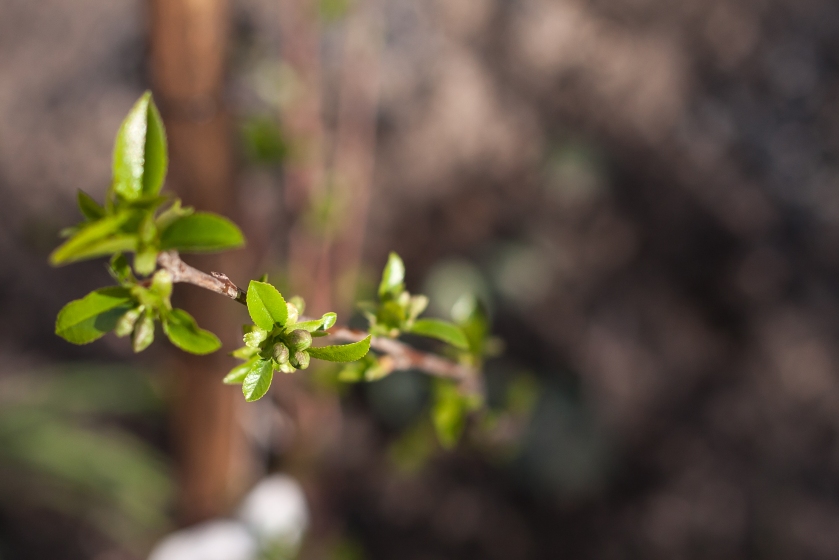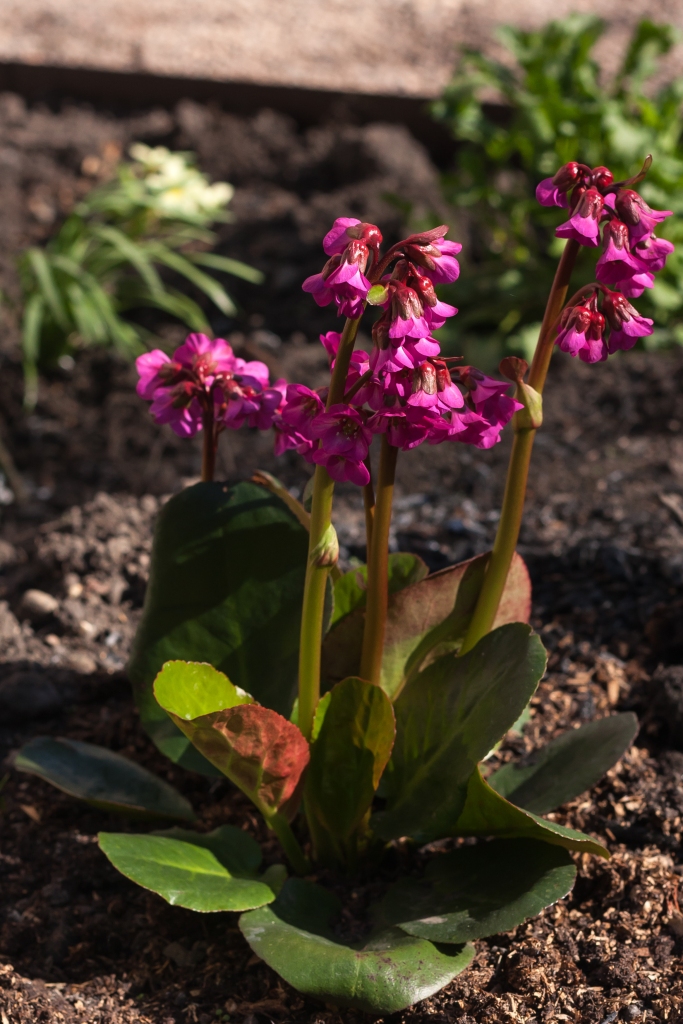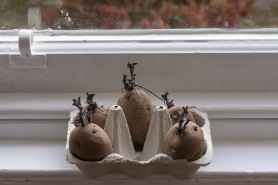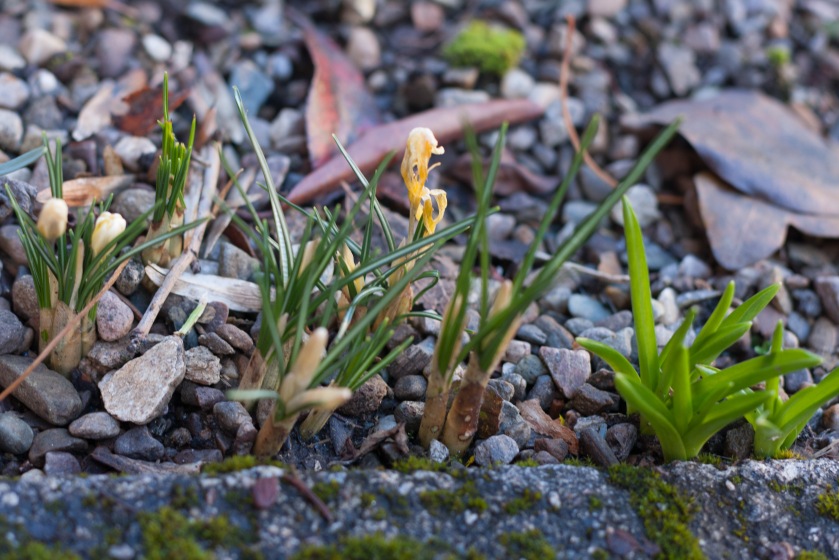

If anyone in Edinburgh didn’t complain about the cold, wet weather of May, it was the owner of a new garden of entirely new plants, whose undeveloped root systems were happy not to cope with warmth and dryness quite yet. What the plants didn’t appreciate this month, however, was the wind. It’s a breezy little manor, this front garden, situated as it is on a North-to-South street, and the gales whip up against the tall buildings and beat back down upon the front gardens like nobody’s business. I can look out at the back green behind the tenement, calm as a monastery, then cross over and look out to the front and see my tulips and daisies practically flattened by insane, punishing winds.


This month brought big changes, from a newly painted shed and bench, new plants, and welcome (if late) blooms. Here are the same views from April. You’ll see that the very attractive rusting incinerator is still in pride of place. Perhaps it will have found a new home by June’s end of month view; we’ll see.
You’ll see from my pictures that the garden is a hotch-potch of experiments. I have been buying whichever plants I like the look of, either that I have admired on other people’s blogs, or have read about in my collection of gardening books, or seen blooming nicely in my neighbours’ front gardens or in the garden centre. Still not quite au fait with the garden itself, its habits of sun and shade, of soil type and drainage, wind direction and so forth, I am working under the expensive but interesting principle of throwing plants in and seeing what sticks. Later this month I’ll write a post specifically on the successes and failures to date. Once it becomes apparent which plants are doing happily, I’ll divide and spread those so that the garden is full of a narrower selection of lush, healthy plants. At the same time I’ll dig out and remove the ones that haven’t done well, whether because of the wind or the shade, or because (like the rather leggy, ragworty daisies just visible in the pictures) I simply haven’t taken a shine to them.
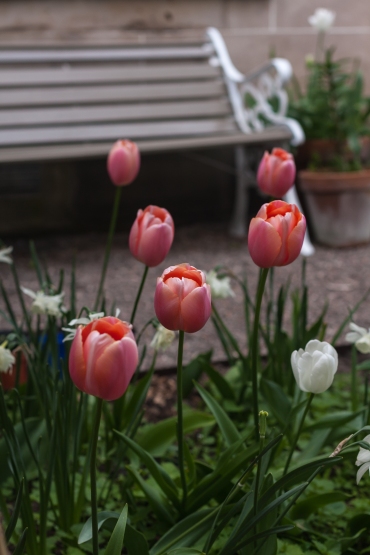
The most dramatic blooms came from my long-awaited, enormous, apricot pink late ‘Menton’ tulips. They exceeded my very high expectations and I cannot recommend these beauties enough, especially if you want to extend your tulip season to May — or even, if you live in the North, into June. If you’re interested in why this tulip is named Menton, just Google for images of the beautiful apricot pink town of Menton, France, and you’ll see.

The three alliums that I bought at Bodnant in March have done well, and I hope they will self-seed and spread a bit. Now that I know they do all right here, I will certainly increase these next year as they provide important height before the foxgloves kick in.
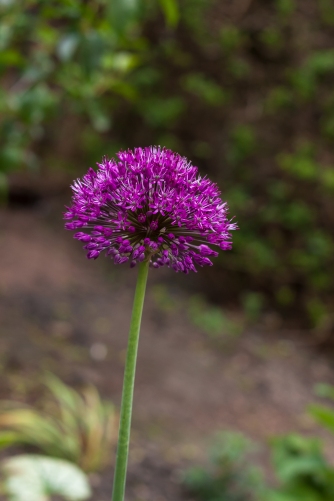
And can anyone else claim to have alliums blooming alongside narcissi? These narcissi I rescued from a tub I had created last year and replanted in January along with the tulips.
 The hostas have been attacked by that aforementioned vicious predator, the wind, so while they remain virgin of slug nibbles, I am sorry to see that the beautiful leaves have been ripped mercilessly in several places.
The hostas have been attacked by that aforementioned vicious predator, the wind, so while they remain virgin of slug nibbles, I am sorry to see that the beautiful leaves have been ripped mercilessly in several places.



This green and yellow hosta was a lovely surprise. The only reason I hadn’t turned out and reused this clay pot of unpromising bare soil, which had been left in the garden by the previous occupier, was that it was acting as a weight on the bottom shelf of the cold frame. Then I noticed unexpected shoots poking through, hastily bought it out and watered it, and shortly appeared the gift of this little hosta. I shall try to divide and repot it at some point.




Elsewhere, we have Ajuga reptans, two lovely new heucheras (I couldn’t decide on the colour so bought both), and this gorgeous new fern, which I thought contrasted beautifully with the faun-brown of the shed. I’ve gone through my bag of labels but I fear the labels for these latter three are in a pot in the cold frame so I’ll fill their names in when I’ve retrieved them.

The hedge is growing back, thankfully, vindicating its heavy pruning; the Brazilian had been saying ‘You’ve gone and killed it’ for weeks, till now.

The potatoes are doing fine in their collapsible potato growers. I’ve had mixed feelings about these growers, finding that non-rigid sides are possibly detrimental to watering and plant stability, although doubtless I’ll appreciate them more when it’s time to fold them up and stow them for the winter. Also, I’ve diverted the large rigid planters I used last year to different purposes, namely to repot the pear tree I haven’t had time to plant out, and the rose (David Austin’s climbing Tess of the D’Urbevilles) which the builders promised most fervently to kill should they find it still in place when they come to put in our French door.

Finally, here are the seedlings I sowed this winter/spring, enjoying their first few days out of the cold frame. (They had to go hastily back inside this week, as early June night temperatures dipped back down to four or five degrees). We have delphiniums, penstemon, aubretia, white cosmos, and a clematis cutting that I did not expect to survive the winter, or the snail attacks, in our rented back garden. Not in the picture is my single experimental dahlia, ‘Cafe au lait’, and two honeysuckles, Serotina and Tellmann’s, rescued from a Morrison’s sale shelf, 99p each and in utter, hopeless despair after a long, sunless in-store sojourn. In fact, they looked about as happy as I do after time spent in a supermarket. Needless to say they’ve bounced back after a week or two outside in the garden.
June will bring a few challenges. The Brazilian took me to the flat last night and proudly displayed the bathroom, which now has not only no basin, lavatory or bath, but no flippin’ floor, before taking me into the kitchen, whose sink has gone the same way. ‘How am I going to water the plants?’ I wailed. I must be the only person scanning the weather forecast in hopes of rain rather than sun. I foresee trips to the flat in the car with buckets, jugs, cans and tubs of water.
End of month view is hosted by Helen at the Patient Gardener.












